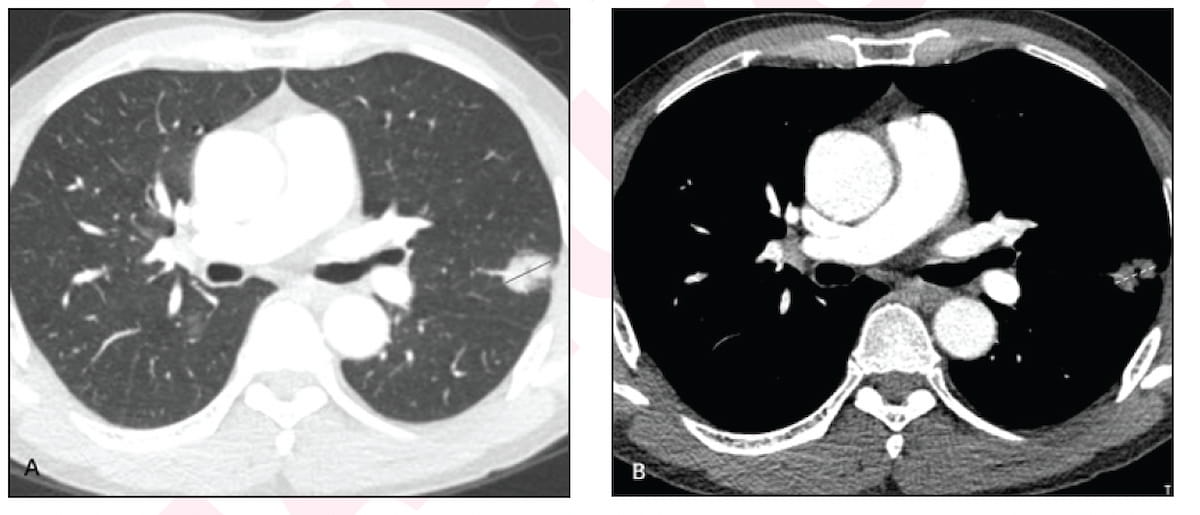For patients with non-small cell lung cancer (NSCLC), new computed tomography (CT) research suggests the presence of minor ground glass opacity (GGO) component may indicate significantly less pathologic lymph node involvement and predict significantly improved five-year outcomes in comparison to those with pure solid lung nodules.
For the retrospective study, recently published in the American Journal of Roentgenology, researchers reviewed preoperative chest CT data from 382 patients (mean age of 61) who had resection of stage 1 NSCLC nodules. According to the study, 106 patients had nodules with a minor GGO component, and 276 patients had pure-solid nodules.
The study authors pointed out that minor GGO nodules had a larger solid component diameter (2.68 cm vs. 2.16 cm) and larger total diameter (2.89 cm vs. 2.16 cm) than pure-solid nodules.
The researchers found that patients with a minor GGO nodule component (< 10 percent) in comparison to those with pure-solid nodules had a greater than 15 percent lower frequency of pathologic lymph node involvement (4.7 percent vs. 20.3 percent) and a more than 10 percent lower frequency of visceral pleural invasion (6.6 percent vs. 17 percent).
Patients with a minor GGO nodule component also had significant more favorable five-year outcomes, according to the study authors. The study results revealed that the presence of a minor GGO nodule component was associated with over a 38 percent higher recurrence-free survival (RFS) rate (83.4 percent vs. 55 percent) and a 16 percent higher cancer-specific survival (CSS) rate (92.4 percent vs. 76.4 percent) in comparison to pure-solid nodules.
“The current results show that the presence of even a small GGO component is associated with significantly better survival in comparison with pure-solid nodules. … The findings indicate that, among NSCLCs, those with a GGO component of any size have distinct biologic behavior from those with a pure-solid appearance, with less aggressive behavior in the former group,” noted lead study author Meiling Li, M.D., who is affiliated with the Department of Radiology at the Shanghai General Hospital (South Branch) at the Shanghai Jiao Tong University School of Medicine in Shanghai, China, and colleagues.
Three Key Takeaways
1. Less pathologic lymph node involvement. Patients with minor GGO components in their NSCLC nodules (< 10 percent) had a significantly lower frequency of pathologic lymph node involvement compared to those with pure-solid nodules (4.7 percent vs. 20.3 percent).
2. Improved five-year outcomes. The presence of a minor GGO component was associated with markedly better five-year outcomes. Specifically, there was over a 38 percent higher recurrence-free survival (RFS) rate (83.4 percent vs. 55 percent) and a 16 percent higher cancer-specific survival (CSS) rate (92.4 percent vs. 76.4 percent) compared to pure-solid nodules.
3. Prognostic implications for radiologists. Given the favorable prognostic impact of minor GGO components, radiologists are advised to meticulously examine CT images for even a minor GGO presence and ensure these findings are clearly documented in their reports, as they indicate less aggressive tumor behavior and better survival rates.
Multivariable analysis revealed that those with pathologic nodal involvement had more than double the risk of cancer-specific death and a larger solid component size had a 50 percent higher risk of cancer-specific death per 1 cm increase in size.
The researchers also noted than air bronchogram was associated with a 54 percent lower risk of recurrence and a minor GGO nodule component resulted in a 63 percent lower recurrence risk in the multivariable analysis.
“Given the favorable prognostic impact, radiologists encountering predominantly solid nodules on CT should carefully scrutinize images for even a minor-GGO component and clearly document such findings within their reports,” noted Li and colleagues.
(Editor’s note: For related content, see “AI Adjudication Bolsters Chest CT Assessment of Lung Adenocarcinoma,” “What Emerging CT Research Reveals About Pure Ground Glass Nodules” and “What a Chest CT Study Reveals About Ground-Glass Opacities and Recurrence with Lung Adenocarcinoma.”)
Beyond the inherent limitations of a retrospective single-center study, the authors noted the cohort had a low percentage of smokers. While the GGO nodule component was independently associated with recurrence-free survival, the study authors noted no independent association with cancer-specific survival in a multivariable analysis.
